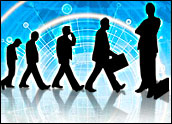
The world of business is in the midst of a profound shift, driven by a convergence of forces — technological, economic and social.
As a result, information must be gathered and managed more efficiently and effectively than ever before, decisions have to be made at every level in an organization with more certainty and immediacy, and information technologies need to be as accessible and easy to use as a mobile phone. The shifting demands are the same for government agencies and non-profit organizations. Indeed, for organizations of nearly every size and type, it’s time to reinvent computing.
The forces driving these changes are irresistible. Digital intelligence is being injected into the world’s physical systems through pervasive instrumentation and global interconnectivity. That’s generating an exponential increase in the volume, quality, and speed of data.
Most important, we are increasingly able to detect patterns and make sense of massive amounts of data in real time, thanks to the rapidly rising capabilities of advanced analytics and supercomputing. Analysis of this new data makes it possible to fundamentally change the way organizations, industries and even societies work.
More Hurdles
At the same time, doing business is growing in complexity because of the increasing connectedness of economic and social systems. Think of a smart grid, a prime example of the changing nature of the work that companies do. These days, rather than just pushing electricity out to customers, utilities increasingly coordinate large, sophisticated networks of equipment and resources, including alternative sources of power, plug-in vehicles, consumer-generated energy, and self-regulating household appliances. It’s a complex system of systems that transforms the utility’s relationship with its customers.
Another challenge: The pace of business has quickened. Companies are under intense pressure to respond to the expectations of a new generation of young people raised on the Internet, the rapid spread of information and opinion on social networks, the emergence of new markets, and intensifying competition.
There Will Be Winners and Losers
To thrive in this environment, organizations need to gather more and better information, make sense of it, and act wisely and immediately on what they learn. Businesses, governmental agencies and societies that master these challenges will win; and those who don’t will lose.
The changing nature of the work that organizations do means they must retool their computing systems to adapt to it. The proliferation of instrumented, interconnected and intelligent devices is creating opportunities for new business models and breakthroughs in services delivered by enterprises. But at the same time, that proliferation is creating dramatic increases in the cost, complexity and risk associated with information technology.
Fortunately, advances are coming in technology and the way IT services are consumed that will help companies make the transition. A new generation of analytics tools is making it possible to handle massive flows of information and perform data analysis on the fly — or even predict accurately what will happen next. New service delivery mechanisms such as cloud computing are making it easier and cheaper to put knowledge into the hands of individuals.
Where It All Goes Wrong
Leaders of corporations and other organizations are hearing about these needs from their IT directors and chief information officers. Over time, the requests for help will grow ever louder. It is estimated that 70 percent of the companies in the global 1,000 will have to radically change their data centers to meet tomorrow’s requirements. For smaller companies, the challenges are just as great.
The problem is, computing, the world’s most important amplifier of human intelligence, isn’t up to the task of handling today’s challenges and opportunities. Data centers and the rest of the computing infrastructure costs too much to provision and operate. It’s inefficient in its use of computing resources and electric power. It’s overly complex, caused in part by the fact that even though all the various machines and software programs often occupy the same physical space, they aren’t very well integrated with one another.
Finally, computing doesn’t provide business leaders and employees with the information and capabilities they need in the form they need it quickly enough.
As a result of these issues, there’s a disconnect between the computing infrastructure and the organizations it’s supposed to serve. Many enterprises face a crisis of IT complexity and inefficiency. And things could get worse.







































All true in principle, with one exception: How can a government agency "lose?" In most cases — the Post Office being an obvious exception — they have a monopoly on whatever government service they’re tasked to provide. And their people are protected by civil service. So where is their incentive to upgrade either their infrastructure or their processes in order to provide better service to their constituents? As someone who has fought this battle for years, even before computing became that critical a part of the equation, I can tell you that making any kind of changes in the government, educational, or other nonprofit sectors is supremely difficult. It really comes down to whether or not it’s important to the leader — what drives his or her political agenda.